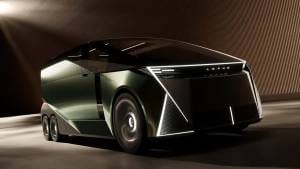2019 Renault Triber first drive review
Since it's the most pressing question on everyone's mind yes, the sub-4m Renault Triber can indeed seat seven people, and it scores extra points for being able to seat seven adults in a fashion nearing comfort! Think about that for a second there are compact SUVs that can't even seat five without breaking a sweat! The second most important thing to know is that it's new 1-litre, 3-cylinder petrol engine is up to the task too, even with a full house.
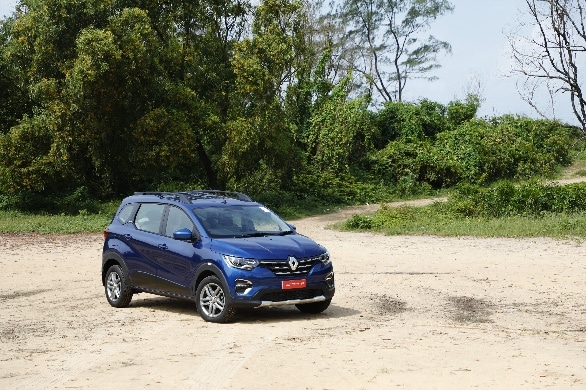
With that out of the way, the Triber is an important car for Renault, a new hope in an already tough market. But could the Triber's mix of 7-seat versatility, cargo space, promised frugality and affordability be just what the doctor ordered?
Is it an SUV or an MPV?
Renault says they don't want to categorise the Triber as either but I'm leaning towards it being more SUV than MPV. It's got a high set hood, with some nice musculature in its twin power domes, and a wide grille with wrap around headlamps accentuating the width and reminding one that Renault designs some really good looking cars.
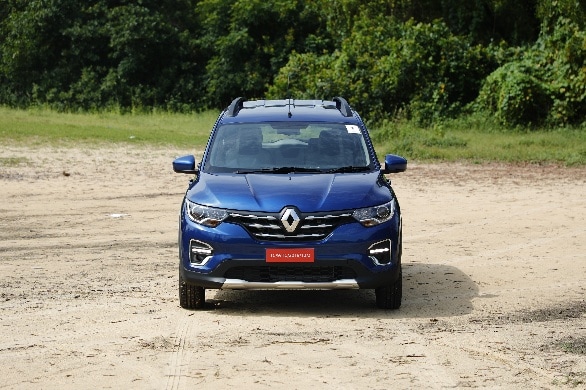
The short hood and steeply raked windscreen aren't very SUV-ish but the near vertical rear could be, and the plastic cladding around the wheel arches and nicely detailed silver skid plates front and rear help. The Triber rides on cleverly designed 15-inch steel wheels that hide the fact well, and also fill up the wheel wells nicely, without too much static gap between tyre and arch. There's a bump in the roof at the second row to help head room but the roof rails are almost entirely successful in hiding it.
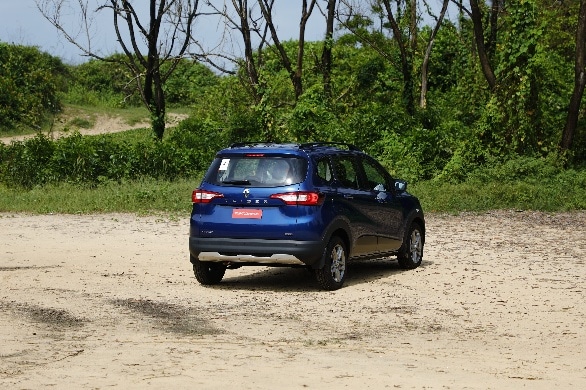
The Triber is underpinned by a tweaked version of the Kwid platform, called the CMF-A+, and at 2,636mm features a near 200mm stretch in wheelbase over the Kwid. That number compares quite favourably against SUVs a couple of segments higher. It's 3,990mm long, 1,739mm wide and 1,643mm in height, with 1822mm of ground clearance. The standout figure being its width, again wider than the Kwid, which truly helps it in the interior space department.
What's the cabin like?
If you've been slightly disappointed in the past with Renault cabins, be prepared to have that notion dispelled quickly. The dash is well laid out, storage spaces are plenty and fall to hand easily, and the dual-tone cabin boasts of better matte-finish plastics and overall finishing, than some other Renaults we've experienced.
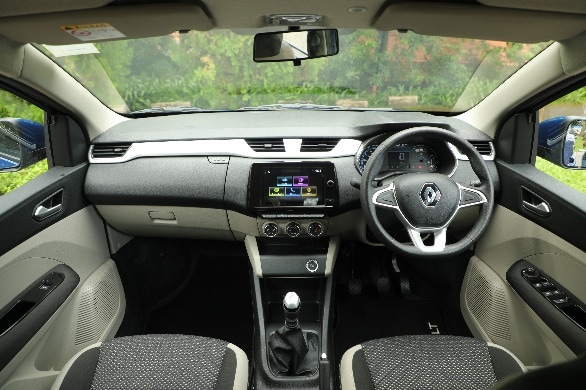
Helping the feeling of perceived quality is the interplay between the surfaces across the dashboard. There are signs of costs having been trimmed but it's been approached cleverly. One that comes to mind is the all digital instrumentation, with a central display screen and a semi-circular tachometer which lights up in quadrants as the revs rise.

The plastic face of the MID itself is slightly low rent but the overall effect is modern, even if the multiple fonts in the display are distracting. The 7.9-inch MediaNav (with Apple/Android connectivity) touchscreen infotainment is new, slightly larger and works slickly, with sound quality from the 6 speaker setup being surprisingly full, with a crisp view through the reversing camera. It also has physical controls for volume, helpful since no steering controls are provided.
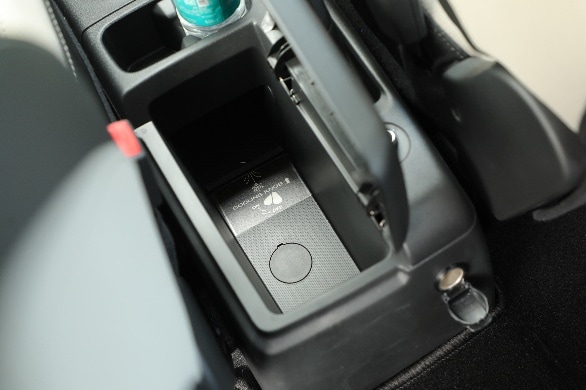
The seats, though they look thin, are actually quite supportive and the fabrics themselves offer different tactility softer and plusher in the central areas, and rougher and firmer in the bolstering sections to keep you in place. With no seat height adjustment, you still sit high enough to see the bulge of the hood but not too high that you feel like you're on top of the car. We did notice that the Triber's cab forward layout means the pedals are closer to you than the steering wheel (which can only be adjusted for take), which could lead to a slightly awkward driving position for anyone over 6ft tall, though it would help shorter drivers immensely.
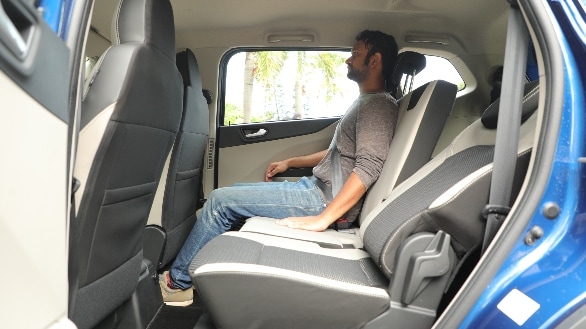
Moving to the rear of the cabin, you have a second row that can be adjusted for kneeroom as well as recline, and the range of adjustment is really generous, offering the chance to really stretch out if one wanted. Passengers here also get separate AC blower controls, and access to a large cooled compartment. The width also means fitting three adults abreast isn't an issue.

The Triber's forte would definitely be its flexibility, since the third row is genuinely usable. The seats aren't that close to the floor that your knees are in your face, and there's even a 12V charging point and AC vents. The third row seats themselves can be folded and are removable in two pieces to make things easier. We were expecting it to be slightly fiddly, as any removable seating usually is, but we're surprised to find their removal and refitment to be straightforward. If I didn't break a sweat in hot and humid Goa doing it multiple times back-to-back for our filming crew, I'm sure it'll be okay. Even access to the second row is simple, with a flip and tumble action to the smaller split of the second row on the co-driver's side.
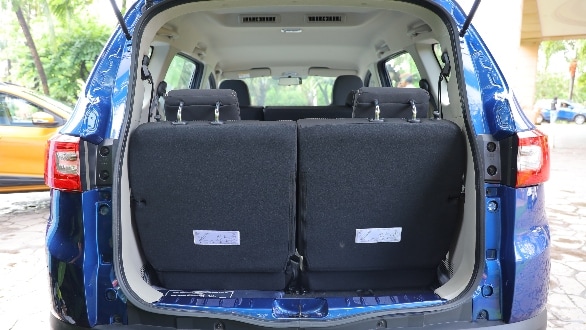
Boot space with all three rows in place is 84 litres and we reckon you'd be able to stuff small soft luggage in there but with one third row seat removed that figure goes to 320 litres which is comparable for the segment, further growing to 625 litres with the smaller second row split tumbled forward.
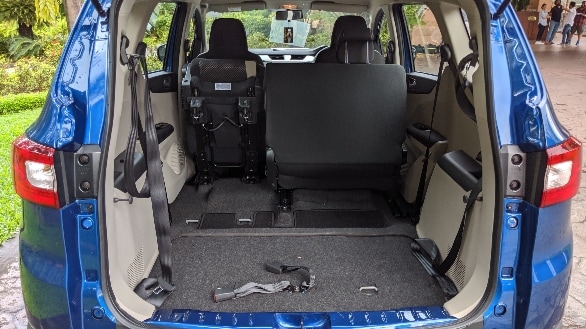
Again, I'm forced to remind myself this is a sub-4m car so the fact that it offers this much is quite a feat in itself! It also gets 2 airbags as standard across the range, with ABS and EBD, while the top end gets an additional two side airbags at the front. The competition tops out at two airbags, and should be taking notes.
How does it drive?
The 999cc, 3-cyl engine (BR10HS) under the Triber's hood is said to be new to India but is essentially the higher spec of the Kwid's powerplant, with the key difference being dual variable valve timing. It's only available with a 5-speed manual gearbox, though an automatic option, most likely an AMT, is expected early next year.
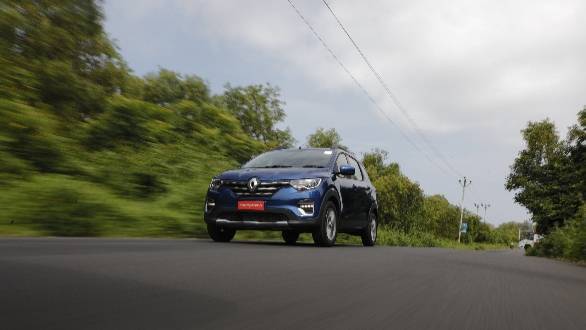
Gearing, including the final drive, has been lowered taking into account the Triber's higher kerb weight (947kg) over the Kwid 1.0 (710kg). Also, to give the engine a fighting chance with seven on board, and like we said earlier, it works well enough though climbing a steep ascent would have you in the higher reaches of the rev range in second or third gear, where the engine doesn't sound its best, and building speed feels like a task.
Though we don't recommend it, dumping your passengers makes the Triber feel like it's gained 15PS or so. It actually feels pretty peppy for a 1-litre engine, but will require you to rev it out to at least 3,000rpm to make quick progress. We don't think it'll set performance benchmarks in the segment but then, it wasn't meant to. The key is in its drivability, with the Triber refusing to judder or lurch even in high gear at low engine speeds hovering just above the 1,000 rpm mark. It feels like more of a city car, since it can take a while to build speed over 100kmph, especially on tighter highways with heavy traffic, like we found on our drive in Goa.
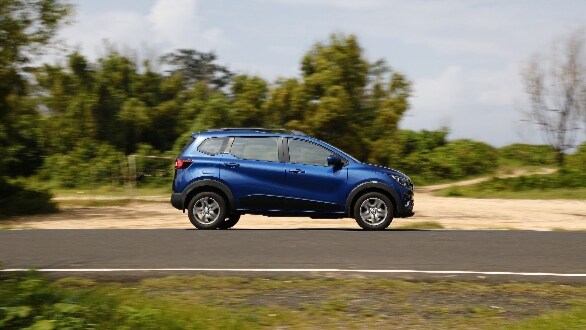
Good news is the very sorted ride quality, offering great bump absorption without losing out in the stability department this with both a full house of passengers, and when driven solo. It did thud into some of the deeper potholes we couldn't avoid but did a stellar job of staying composed over bad roads, letting very little filter into the cabin, and with surprisingly little to no bounce on rebound. Even with seven passengers body roll in corners wasn't alarming but you'll probably hear yells to slow down if you try to go above what most consider a comfortable pace. With fewer passengers on board, the handling improves to the point where you can let the Triber lean into corners and still hold its line. The steering is light and direct but still feels reassuringly connected at speed, though we'd reserve final judgement once we're able to get it up to higher triple digits. Hauling the Triber down from speed shouldn't be an issue either, with a progressive brake feel and, again, surprising composure.
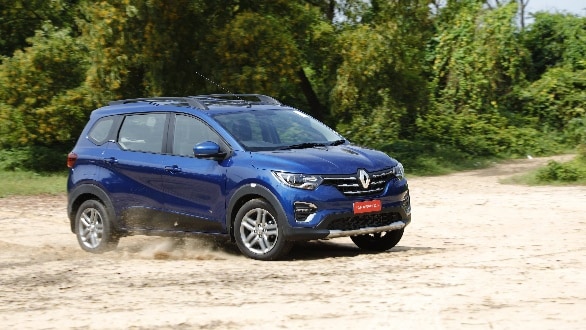
Verdict
With prices starting at Rs 4.95 lakh, going up to Rs 6.49 lakh (ex-showroom) for this RXZ variant we tested, the Triber makes quite a convincing case for itself for the family-oriented customer looking for a little more flexibility than what the current crop of hatchbacks offer. We already know our market is fascinated with seven seats, and the Triber does offer true seven seat capabilities, so the Triber's success story, really, should write itself.
Also see: Renault Triber | First Drive
Starts Rs 5.3 Lakhs
999cc
AMT
72
96
20.5 Kmpl

